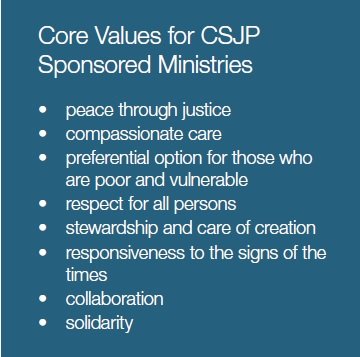Peace Ministries
by Kate Chambers, CSJP-A
Tending Hopes and Aspirations
Nearly 100 years ago, my grandmother transformed the fields near her home by planting two silver maple trees side-by-side in the yard. Today, her descendants gather for refreshments and conversation underneath their canopy, children soar with glee and daring in the tire swinging from the branches, and visitors head to the hammock for restorative respite. I never met my grandmother since she died before I was born. However, it’s easy to imagine her as a person of hope by all that she left growing. She saw something beyond herself as she imagined, planted, and cultivated her garden. She coaxed life and beauty out of the uninviting, stony soil, growing still surviving daffodils, lilacs, and rambling roses along with her majestic trees. Her vision left a legacy of living gifts enjoyed, treasured and tended for generations.
It has been said that the one who plants a tree plants hope (Lucy Larcom). While that may be said of my grandmother, it is also true for the work of the Sisters of St. Joseph of Peace who first rooted hope when they began establishing their ministries in New Jersey in 1885. Their compassionate care of and voice for women and children on the margins of society, offered in Jesus’ name, was the visible expression of their desire to promote gospel peace. Collaborating with others who shared their dream for peace through justice, they established and sponsored St. Joseph’s School for the Blind, Holy Name Medical Center, Peace Care St. Ann’s, Peace Care St. Joseph’s, York Street Project, and WATERSPIRIT.
Today these works continue into the new millennium, changing and adapting to the circumstances of present realities. As these ministries move forward, so do the hopes of the Congregation which are always evolving: sending out new shoots, inviting growth, and changing familiar landscapes. The Congregation’s careful cultivation of the founding values led to the formation of Peace Ministries, Inc. in 2014 to provide a vibrant future for their sponsored institutions in New Jersey. Under the direction of the Congregation Leadership Team, a task force defined a new organizational structure to bring the ministries together into an integrated governance model based on a commitment to the common goal of offering compassionate service for people in need.
The committee also developed a touchstone document for Peace Ministries called “Hopes and Aspirations for the Future of Our Ministries.” This document outlines dreams “for the ministries presently undertaken, for all that may develop in the future, and for the women and men who commit themselves to this work of service.” Rather than focusing on the idea of leaving a legacy, “Hopes and Aspirations” envisages a more dynamic, aspirational movement of carrying the CSJP mission and charism of peace through justice into the future. It proclaims that the common vision that unites all the ministries is Christ’s gospel of peace which is summed up in the call to act justly, love tenderly and to walk humbly with God. By articulating the core values “Hopes and Aspirations” serves to inspire, anchor, and guide Peace Ministries as it collaborates with the Congregation and sponsored ministries to meet the challenges demanded by a new time.
For Peace Ministries, which has been entrusted by the Congregation with the awesome charge of supporting the ministries into the future, “Hopes and Aspirations” lays out the values and principles that are most precious to the Congregation along with a charge to look at how they are lived out. This founding call permeates the work of Peace Ministries, grounding its mission statement, board and staff conversations, decision-making, future planning and shared prayer. It is written in the hearts of its trustees and staff members who return to it again and again for grounding and inspiration. This, however, is not enough for hope to thrive.
Nurturing Hope
In addition to deriving strength from the gifts of the past and gathering energy from a prophetic vision of the future, hope must live in the often ambiguous present, taking steps to bridge the gap between what has been and what will be. Hope must be tended.
So how has Peace Ministries begun to live out its call? How has Peace Ministries been living and nurturing hope?
Hosting twice yearly gatherings for prayer, education, networking and community building among the ministry and board leaders of the sponsored ministries.
Organizing the first “Foundations of Catholic Ministry Leadership” course for leaders of the sponsored ministries. This two-day program focuses on the personal and spiritual competencies needed by those who lead. Offering such formational opportunities for ministry and board leaders provides a foundation and puts legs on our hope for the future.
Providing prayer materials for boards and ministries centered on themes of Catholic Social Teaching as well on CSJP values and history. Members of the sponsored ministries are encouraged to celebrate the legacy of Mother Clare and the feast of our patron, St. Joseph.
Supporting several of the individual ministries’ needs for securing strategic planning assistance as they move into the future.
Creating an umbrella corporation, Peace Care, and supporting the integration of operations of the two sponsored nursing homes, to optimize resources and better position them to compete in a changing healthcare landscape.
Celebrating the ordinary, and sometimes extraordinary, hope offered by the ministries in the day in and day out services they provide.
Exploring opportunities to enhance the advocacy efforts of the sponsored ministries.
The saplings that my grandmother planted were actually offshoots of a long-standing tree growing on a neighboring farm. Her work to bring shade to her home coaxed life in abundance from old root stock. So, too, may the work of Peace Ministries, embedded in the hopes and heritage of the Sisters of St. Joseph of Peace, generate new opportunities in response to the signs of the times for bringing Christ’s gospel of peace to the world. May peace through justice flourish anew.
This article appeared in the Spring 2018 issue of Living Peace.


